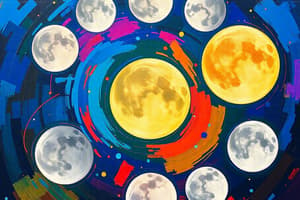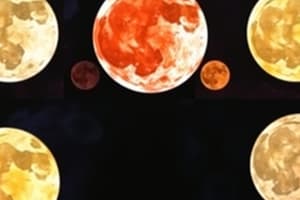Podcast
Questions and Answers
What is the primary reason that the moon is not visible during a new moon phase?
What is the primary reason that the moon is not visible during a new moon phase?
- The moon is located between the Earth and the sun. (correct)
- The moon is in the shadow of the Earth.
- The moon is too far away from the Earth to be visible.
- The moon's surface is not reflecting any sunlight.
Which scientist was the first to make scientific observations of the moon using a telescope?
Which scientist was the first to make scientific observations of the moon using a telescope?
- Isaac Newton
- Johannes Kepler
- Galileo Galilei (correct)
- Copernicus
What is the primary reason the moon is considered an important celestial body for human space exploration?
What is the primary reason the moon is considered an important celestial body for human space exploration?
- The moon is the only celestial body beyond Earth that humans have visited directly. (correct)
- The moon has a similar surface composition to Earth.
- The moon is the closest celestial body to Earth.
- The moon has an atmosphere that is suitable for human habitation.
What is the primary reason the moon's surface is described as "soft" and "powdery"?
What is the primary reason the moon's surface is described as "soft" and "powdery"?
What is the primary reason the moon is considered to be an "old" celestial body?
What is the primary reason the moon is considered to be an "old" celestial body?
Study Notes
The Moon: Earth's Nearest Neighbor and Natural Satellite
The moon has been enticing humans since ancient times, being a constant companion in our night sky. Formed approximately 4.5 billion years ago, the moon plays a crucial role in shaping Earth's climate and creating tides. In this article, we will delve into various aspects of the moon, its formation, impact on Earth, exploration history, and interesting facts that make it a subject of fascination for people worldwide.
Formation of the Moon
The moon's formation is believed to have occurred when a large collision between Earth and another celestial body, possibly around Mars size, caused debris to coalesce into what we now know as the moon. Evidence suggests that this event happened shortly after the formation of our solar system.
Impact on Earth's Climate and Tides
The moon's presence helps stabilize Earth's climate by influencing its axis tilt. This regularity leads to four distinct seasons throughout the year. Additionally, the gravitational pull exerted by the moon causes the rise and fall of sea levels known as tides. These tides can significantly affect various forms of marine life, which often time their breeding cycles according to lunar phases.
Phases of the Moon
As the moon orbits Earth, it passes through different phases due to sunlight reflecting off its surface from our perspective. During a full moon, one entire half of the moon appears lit because the Earth lies between the moon and the sun. Conversely, during a new moon, none of the moon is visible since it resides between the Earth and the sun.
Exploration History
Over centuries, humans have been curious about this celestial body. From ancient Greek philosophers who believed the moon was a sphere orbiting Earth based on observations through telescopes, to Galileo Galilei being the first to make scientific observations of the moon using a telescope in 1609, our understanding of the moon has evolved significantly.
In the mid-20th century, the Space Race between the United States and the Soviet Union led to increased interest in exploring the lunar surface. Several missions were launched during this period, culminating in NASA's Apollo program, which achieved the monumental feat of landing astronauts on the moon between 1968 and 1972. Since then, numerous robotic missions have been sent to explore various aspects of the lunar surface and geological history. Despite these efforts, the moon remains the only celestial body beyond Earth that humans have visited directly.
Interesting Facts About the Moon
- Surface composition: The moon has a soft, powdery surface similar to desert landscapes.
- No atmosphere: Unlike Earth, the moon lacks an atmosphere, making life unsustainable there.
- Old age: Estimated to be more than 4.5 billion years old.
- Tidal locking: Due to synchronous rotation, we always see one side of the moon.
- Water discovery: Recent studies revealed that water exists in rocks brought back from the moon during the Apollo missions.
These intriguing facts highlight the importance of continued research and exploration into our cosmic neighbor, providing valuable insights into both astronomical phenomena and potential future human space travel.
Studying That Suits You
Use AI to generate personalized quizzes and flashcards to suit your learning preferences.
Description
Test your knowledge about the moon, Earth's natural satellite that has captivated humans for centuries. Explore its formation, impact on Earth, phases, exploration history, and interesting facts like its surface composition and water discovery.




